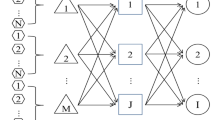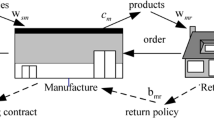Abstract
Mathematical model formulations for single-period supply chain problem depend on how to describe the demand. This paper applies uncertainty theory, which is a branch of axiomatic mathematics for dealing with human uncertainty, to model demand distribution. Uncertain decentralized management model and uncertain centralized management model are developed. Unique closed-form solutions for the two models are derived. The belief degree of “order quantity being less than the supply chain optimal order quantity” is proposed and the lower bound of the belief degree is obtained and carefully analyzed. Finally, some examples are presented to illustrate our method.


Similar content being viewed by others
References
Araneda-Fuentes C, Lustosa LJ, Minner S (2015) A contract for coordinating capacity decisions in a business-to-business (B2B) supply chain. Int J Prod Econ 165:158–171
Awudu I, Zhang J (2013) Stochastic production planning for a biofuel supply chain under demand and price uncertainties. Appl Energy 103:189–196
Chen TH (2011) Coordinating the ordering and advertising policies for a single-period commodity in a two-level supply chain. Comput Ind Eng 61(4):1268–1274
Chen XW (2011) American option pricing formula for uncertain financial market. Int J Oper Res 8(2):32–37
Ding SB (2013) Uncertain multi-product newsboy problem with chance constraint. Appl Math Comput 223:139–146
Ding SB (2014) Uncertain random newsboy problem. J Intell Fuzzy Syst 26(1):483–490
Dominey MJG, Hill RM (2004) Performance of approximations for compound Poisson distributed demand in the newsboy problem. Int J Prod Econ 92(2):145–155
Edgeworth FY (1888) The mathematical theory of banking. J Roy Stat Soc 51(1):113–127
Ehrhardt R, Taube L (1987) An inventory model with random replenishment quantity. Int J Prod Res 25(12):1795–1803
Gallego G, Moon I (1993) The distribution free newsboy problem: review and extensions. J Oper Res Soc 44(8):825–834
Gao XL, Gao Y (2013) Connectedness index of uncertain graphs. Int J Uncertain Fuzziness Knowl Based Syst 21(1):127–137
Gao Y, Wen ML, Ding SB (2013) (\(s\), \(S\)) policy for uncertain single period inventory problem. Int J Uncertain Fuzziness Knowl Based Syst 21(6):945–953
Gao Y, Yang LX, Li SK, Kar S (2015) On distribution function of the diameter in uncertain graph. Inf Sci 296:61–74
Hadley G, Whitin TM (1963) Analysis of inventory systems. Prentice-Hall, New Jersey
Hill RM (1997) Applying Bayesian methodology with a uniform prior to the single period inventory model. Eur J Oper Res 98(3):555–562
Hua ZS, Li SJ (2008) Impacts of demand uncertainty on retailers dominance and manufacturer-retailer supply chain cooperation. Omega Int J Manag Sci 36(5):697–714
Hua ZS, Li SJ, Liang L (2006) Impact of demand uncertainty on supply chain cooperation of single-period products. Int J Prod Econ 100(2):268–284
Huang KL, Kuo CW, Lu ML (2014) Wholesale price rebate vs. capacity expansion: the optimal strategy for seasonal products in a supply chain. Eur J Oper Res 234(1):77–85
Kabak IW, Schiff AI (1978) Inventory models and management objectives. Sloan Manag Rev 19(2):53–59
Kalpana P, Kaur A (2011) Optimal ordering decisions and revenue sharing in a single period split order supply chain. Technol Prod Oper 2(2):61–79
Lariviere MA, Porteus EL (2001) Selling to the newsvendor: an analysis of price-only contracts. Manuf Serv Oper Manag 3(4):293–305
Lau HS (1980) Some extensions of Ismail-Louderback’s stochastic CVP model under optimizing and satisfying criteria. Decis Sci 11(3):557–561
Lin J, Ng TS (2011) Robust multi-market newsvendor models with interval demand data. Eur J Oper Res 212(2):361–373
Liu B (2007) Uncertainty theory, 2nd edn. Springer, Berlin
Liu B (2009) Some research problems in uncertainty theory. J Uncertain Syst 3(1):3–10
Liu B (2010) Uncertainty theory: a branch of mathematics for modeling human uncertainty. Springer, Berlin
Mahoney JF, Sivazlian BD (1980) Probability of shortage for Erlang distributed demand in a \((\sigma, S)\) inventory problem. SIAM J Appl Math 38(1):156–162
Pasternack BA (1985) Optimal pricing and return policies for perishable commodities. Mark Sci 4(2):166–176
Petruzzi NC, Dada M (1999) Pricing and the newsvendor problem: a review with extensions. Oper Res 47(2):183–194
Qin ZF (2015) Mean-variance model for portfolio optimization problem in the simultaneous presence of random and uncertain returns. Eur J Oper Res 245(2):480–488
Qin ZF, Kar S (2013) Single-period inventory problem under uncertain environment. Appl Math Comput 219(18):9630–9638
Qin Y, Wang R, Vakharia AJ, Chen Y, Seref MMH (2011) The newsvendor problem: review and directions for future research. Eur J Oper Res 213(2):361–374
Scarf HE (1958) A min-max solution of an inventory problem. In: Arrow KJ, Karlin S, Scarf HE (eds) Studies in the mathematical theory of inventory and production. Stanford University Press, Stanford, pp 201–209
Tadikamalla PR (1978) Applications of the Weibull distributions in inventory control. J Oper Res Soc 29(1):77–83
Tadikamalla PR (1979) The lognormal approximation to the lead time demand in inventory control. Omega Int J Manag Sci 7(6):553–556
Vairaktarakis GL (2000) Robust multi-item newsboy models with a budget constraint. Int J Prod Econ 66(3):213–226
Wang ZF, Qin S Kar (2015) A novel single-period inventory problem with uncertain random demand and its application. Appl Math Comput 269:133–145
Wang D, Qin ZF (2016) Multi-product newsvendor problem with hybrid demand and its applications to ordering pharmaceutical reference standard materials. Int J Gen Syst 45(3):271–285
Yang XF, Gao JW (2013) Uncertain differential games with application to capitalism. J Uncertain Anal Appl 1:17
Yao K, Ralescu DA (2013) Age replacement policy in uncertain environment. Iran J Fuzzy Syst 10(2):29–39
Yu J, Sarker BR, Duan Q, Wu B (2012) Single-manufacturer, multi-retailer consignment policy for retailers generalized demand distributions. J Oper Res Soc 63(12):1708–1719
Zhu YG (2010) Uncertain optimal control with application to a portfolio selection model. Cybern Syst 41(7):535–547
Acknowledgements
This work was supported by the National Natural Science Foundation of China (Grant No. U1404701), the Scholarship Programm of China Scholarship Council (Grant No. 201509895007), the Soft Science Research Program of Henan Province (Grant No. 152400410447), the Science Foundation of Henan University of Technology (Grant No. 2017RCJH11) and the Key Research Base of Humanities and Social Sciences for Universities in Henan Province.
Author information
Authors and Affiliations
Corresponding author
Ethics declarations
Conflict of interest
The authors declare that they have no conflict of interest.
Human and animal rights
This article does not contain any studies with human participants or animals performed by any of the authors.
Additional information
Communicated by V. Loia.
Rights and permissions
About this article
Cite this article
Ding, S. Belief degree of optimal models for uncertain single-period supply chain problem. Soft Comput 22, 5879–5887 (2018). https://doi.org/10.1007/s00500-017-2736-y
Published:
Issue Date:
DOI: https://doi.org/10.1007/s00500-017-2736-y




